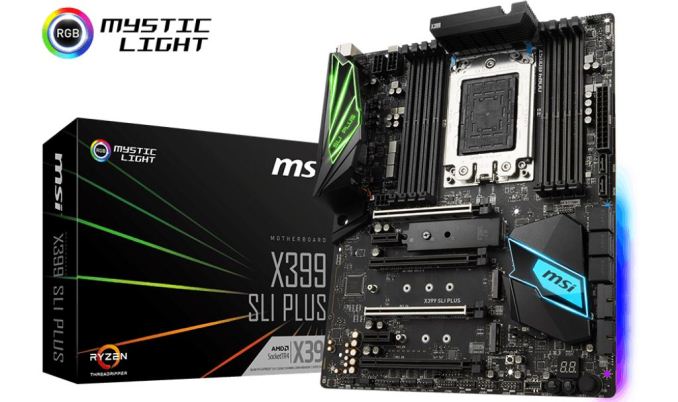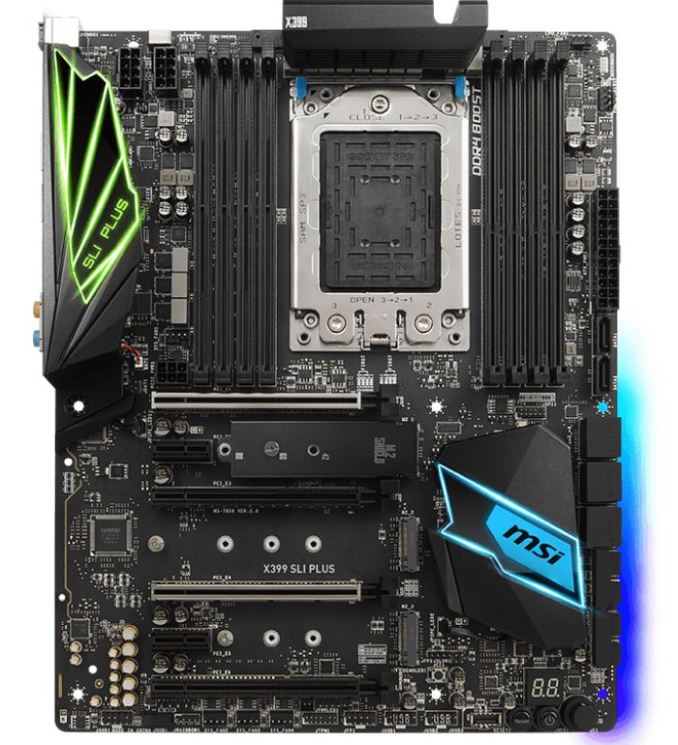An AMD Threadripper X399 Motherboard Overview: A Quick Look at Seven Products
by Ian Cutress & Joe Shields on September 15, 2017 9:00 AM ESTThe MSI X399 SLI Plus
As with other X399 boards, the MSI X399 SLI Plus uses eight total memory slots, although these are not reinforced. This configuration allows for up to 128GB of RAM in a quad channel setup. MSI uses their DDR4 Boost technology on the SLI Plus and lists memory speed support up to DDR4-3600+.
Power delivery is handled by a fully digital 13 phase VRM which looks quite similar to the Gaming Pro Carbon AC. Per the Military Class VI specs, it uses Titanium chokes and 'dark' capacitors. We cannot confirm by the pictures, however, it is likely using the same DrMOS ICs found on the Pro Carbon. Power is fed to the VRMs by two 12V CPU leads (one is optional) located in the upper left-hand corner of the board. The SLI Plus has a full two character debug LED as well as a simplified four LED debug system with LED’s for Boot, VGA, DRAM, and CPU.
The SLI Plus has a total of six PCIe slots: two PCIe 2.0 x1 slots and four full-length PCIe 3.0 slots. The two main GPU slots, capable of running x16/x16 if they are the only ones populated, are reinforced with MSI’s Steel Armor to support heavy video cards and prevent potential damage to the slot. The motherboard supports 4-Way NVIDIA SLI and 4-Way AMD Crossfire technologies.
For storage, the SLI Plus has a total of eight SATA ports fed from the chipset, and has the same physical location and orientation of the Pro Carbon; six horizontal and two vertical. There are a total of three PCIe 3.0 x4 M.2 slots which get their lanes from the CPU. Two of the M.2 slots support up to 80mm drives, while the middle slot can handle up to 110mm modules. Only the top M.2 slot has a heatsink for cooling down the installed M.2 module. U.2 support does not make it to the SLI Plus.
The audio side of the house is managed by a Realtek ACL1220 codec working in conjunction with MSI’s Audio Boost 4 suite. While the Nahimic software package normally found on the gaming products does not make its way here, the SLI Plus uses separate audio layers for left and right channels, de-pop protection, Chemi-Con audio capacitors, EMI shielding and board separation, and a dedicated headphone amplifier which auto-detects impedance (use up to 600Ω).
As far as the overall aesthetic, MSI uses a black PCB and color scheme and lets the integrated RGB LEDs fit whatever theme a builder has in mind. LEDs make it on the back panel IO shroud, chipset heatsink, and a strip found on the back of the board under the SATA ports. Additional RGB LED strips can be added via the two onboard RGB headers. One is for a rainbow strip, while the other for general RGB; both are controlled by MSI’s Mystic Light software.
Pricing was not listed, but we do expect the SLI Plus to come in under the Gaming Pro Carbon. We should see these available for purchase soon.
| MSI X399 SLI PLUS | |
| Warranty Period | 3 Years |
| Product Page | Link |
| Price | N/A |
| Size | ATX |
| CPU Interface | TR4 |
| Chipset | AMD X399 |
| Memory Slots (DDR4) | Eight DDR4 Supporting 128GB Quad Channel Up to 3600 MHz (OC) Supports ECC UDIMM (in non-ECC mode) |
| Network Connectivity | 1 x Intel Gigabit LAN controller |
| Onboard Audio | Realtek ALC1220 |
| PCIe Slots for Graphics (from CPU) | 4 x PCIe 3.0 x16 |
| PCIe Slots for Other (from Chipset) | 2 x PCIe 2.0 x1 |
| Onboard SATA | 8 x Supporting RAID 0/1/10 |
| Onboard SATA Express | None |
| Onboard M.2 | 3 x PCIe 3.0 x4 - NVMe or SATA |
| Onboard U.2 | None |
| USB 3.1 | 1 x Type-C (ASMedia) 1 x Type-A (ASMedia) 1 x Internal Header |
| USB 3.0 | 4 x USB 3.0 |
| USB 2.0 | 2 x Back Panel 2 x Headers |
| Power Connectors | 1 x 24-pin ATX 2 x 8-pin CPU |
| Fan Headers | 1 x CPU (4-pin) 1 x Water Pump (4-pin) 4 x System Fan (4-pin) |
| IO Panel | 1 x Clear CMOS button 1 x BIOS FLASHBACK+ button 1 x PS/2 keyboard/mouse combo port 2 x USB 2.0 Type-A ports 8 x USB 3.0 Type-A ports 1 x LAN (RJ-45) 1 x USB 3.1 Type-A port 1 x USB 3.1 Type-C port 5 x Audio Jacks 1 x Optical S/PDIF OUT connector |

















99 Comments
View All Comments
nathanddrews - Friday, September 15, 2017 - link
The ROG Zenith has all the networking IO I want, but is lacking in SATA ports. Hmm...tarqsharq - Friday, September 15, 2017 - link
With all those extra PCI-E lanes you can just use add-in boards for anything you need more of.Gothmoth - Friday, September 15, 2017 - link
yeah lol at another 100 euro... i tried SATA cards from 6 different brands and all SUCKED.delock, i-tec, syba, logiclink.
just read the reviews at retailers.. these cheap cards are buggy as hell.
i ended up with an adaptec card that works well. but it cost 100+ euro.
nathanddrews - Friday, September 15, 2017 - link
Yes, that has been my experience as well.ddriver - Friday, September 15, 2017 - link
Cheap SATA controller cards use exactly the same chips which mobo makers put to increase the number of ports up from what the chipset provides. Complaining the board doesn't come with extra ports via a cheap controller and then complaining cheap controllers are no good? Seriously?A proper TR build would be at least 3000$, in that price range, 200$ for a good HBA like the LSI 9300-8i should not be an issue. Surely, AMD offers great value and brought extremely high performance to a new level of affordability, but this is not, I repeat, NOT a product for penny pinchers.
mWMA - Monday, September 18, 2017 - link
The correct solution adding more sata is not use SAS2 cards. You can pick up a nice x4 PCIe G3 lsi or IBM SAS2 card for about 100 bucks or less on ebay.. Without any HBA, you can run 8 drives off those 2 sas controller cards since each one will give you x4 lanes.. you can get easily 500+ MB/s out of each controller.mWMA - Monday, September 18, 2017 - link
Correction.. not to use SATA cards.. use SAS2 or SAS3 cards insteadBoemlauweBas - Friday, October 20, 2017 - link
The problem however, these cards suck a golfball through a garden hose performance wise compared to onboard softraid. And before people go ape-sh!t that softraid is bad-mkay... ever looked under the hood of lets say .... EMC / NetApp or any NAS semi/pro vendor out there ? It's all Softraid. Why ? Because the hardware raid chipsets that can actually cope with 3Gb/8Gb throughput are relative new & start around 3K $. So, a poor mans 8x sata 600 onboard chipset is hard 2 beat.karatekid430 - Thursday, October 26, 2017 - link
Yeah, you can get U.2 SFF-8643 to 4x SATA branch-out cables. I have a feeling it won't work directly off U.2 PCIe 3.0 x4 (although who knows?), but surely a PCIe SAS controller providing some SFF-8643 connectors will work. That is the way I was thinking.CheapSushi - Sunday, September 17, 2017 - link
How about going for something more serious then instead of low end: http://www.highpoint-tech.com/USA_new/series-ssd71...That would give you 16 SATA drives.